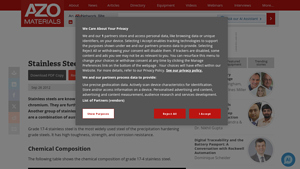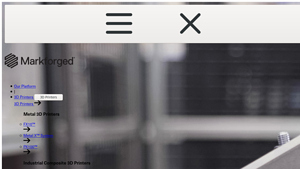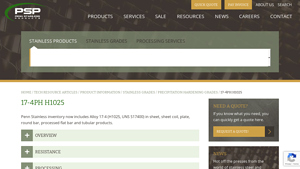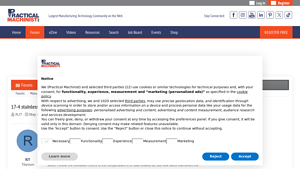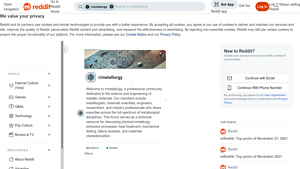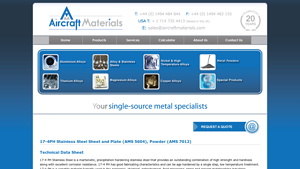17 4 Stainless Steel Hardness Guide: Type, Cost, Top List…
Introduction: Navigating the Global Market for 17 4 stainless steel hardness
Navigating the global market for 17-4 stainless steel hardness presents a unique challenge for international B2B buyers. With a diverse range of grades, each offering distinct mechanical properties and applications, sourcing the right material can significantly impact operational efficiency and product quality. This guide delves into the intricacies of 17-4 stainless steel, providing an in-depth examination of its various hardness conditions, including H900, H1025, and H1150, and their corresponding implications for performance across different sectors such as aerospace, oil and gas, and chemical processing.
Our comprehensive resource aims to empower buyers from Africa, South America, the Middle East, and Europe—regions where the demand for high-quality, durable materials is on the rise. By outlining critical considerations such as supplier vetting processes, cost analysis, and application-specific recommendations, this guide equips decision-makers with the insights needed to make informed purchasing choices. Whether you’re looking to enhance corrosion resistance in harsh environments or seeking high tensile strength for demanding applications, understanding the nuances of 17-4 stainless steel hardness is vital.
Join us as we explore the essential factors that influence the selection of this versatile alloy, ensuring that your procurement strategies align with your business objectives and market demands.
Understanding 17 4 stainless steel hardness Types and Variations
| Type Name | Key Distinguishing Features | Primary B2B Applications | Brief Pros & Cons for Buyers |
|---|---|---|---|
| H900 | Maximum hardness and strength; hardness range 40-47 HRC | Aerospace components, tooling applications | Pros: Highest strength, excellent wear resistance. Cons: More challenging to machine due to high hardness. |
| H1025 | Moderate hardness with good ductility; hardness range 33-39 HRC | Oil & gas industry, chemical processing | Pros: Balanced properties for machining and strength. Cons: Lower strength compared to H900. |
| H1075 | Lower hardness than H900; hardness range 28-37 HRC | General manufacturing, automotive parts | Pros: Easier to machine, good corrosion resistance. Cons: Reduced hardness limits high-stress applications. |
| H1150 | Lower hardness with improved toughness; hardness range 25-33 HRC | Food processing, marine applications | Pros: Excellent toughness and formability. Cons: Not suitable for high-load applications. |
| H1150D | Similar to H1150 but with enhanced ductility; hardness range 25-33 HRC | Aerospace, defense applications | Pros: Enhanced ductility for complex shapes. Cons: Lower hardness limits wear resistance. |
What Are the Key Characteristics of H900 17-4 Stainless Steel?
H900 is recognized for its maximum hardness, achieving a Rockwell hardness of 40-47 HRC. This variant is particularly suited for high-stress applications where strength and wear resistance are critical, such as in aerospace components and tooling. Buyers should consider the challenges associated with machining H900, as its hardness can complicate the manufacturing process, requiring specialized tooling and techniques.
How Does H1025 Compare in Terms of Ductility and Strength?
H1025 offers a balance between hardness and ductility, with a hardness range of 33-39 HRC. This makes it ideal for applications in the oil and gas industry and chemical processing, where moderate strength and good formability are essential. While it provides better machinability than H900, buyers must weigh its lower strength against the requirements of their specific applications.
Why Choose H1075 for General Manufacturing Needs?
H1075 is characterized by lower hardness (28-37 HRC) while still offering good corrosion resistance. It is well-suited for general manufacturing and automotive parts, where ease of machining is a priority. However, its reduced hardness limits its use in high-stress scenarios, making it less suitable for applications requiring maximum strength.
What Are the Advantages of H1150 for Toughness and Formability?
H1150 presents lower hardness levels (25-33 HRC) but excels in toughness and formability, making it ideal for food processing and marine applications. Its excellent toughness allows for complex shapes and designs, which are often required in these industries. Buyers should note that its lower hardness may not meet the requirements for high-load applications.
How Does H1150D Enhance Ductility for Specialized Applications?
H1150D shares characteristics with H1150 but is designed for improved ductility, making it suitable for aerospace and defense applications. It maintains a hardness range of 25-33 HRC while allowing for greater flexibility in design and manufacturing. Buyers looking for materials that can accommodate complex shapes should consider H1150D, albeit with the understanding that its lower hardness may compromise wear resistance in demanding environments.
Key Industrial Applications of 17 4 stainless steel hardness
| Industry/Sector | Specific Application of 17 4 stainless steel hardness | Value/Benefit for the Business | Key Sourcing Considerations for this Application |
|---|---|---|---|
| Aerospace | Aircraft components such as landing gear and engine parts | High strength and lightweight properties enhance performance | Ensure compliance with aerospace material standards and certifications |
| Oil and Gas | Valve and pump components for harsh environments | Excellent corrosion resistance prolongs equipment lifespan | Consider sourcing from suppliers with experience in high-pressure applications |
| Chemical Processing | Heat exchangers and reactor vessels | Durability and resistance to chemical attack reduce maintenance costs | Verify compatibility with specific chemicals and operating conditions |
| Food Processing | Equipment for food handling and processing | Non-reactive properties ensure food safety and hygiene | Source from suppliers with certifications for food-grade materials |
| Defense and Military | Weapon systems and tactical gear | Superior hardness and toughness enhance reliability under extreme conditions | Prioritize suppliers with experience in defense-grade materials and specifications |
How is 17-4 Stainless Steel Hardness Applied in the Aerospace Sector?
In the aerospace industry, 17-4 stainless steel is crucial for manufacturing components like landing gear and engine parts. The alloy’s high hardness and tensile strength ensure that parts can withstand extreme conditions while remaining lightweight. This is particularly important for aircraft performance, where weight savings can lead to fuel efficiency. Buyers should seek suppliers who adhere to aerospace material standards and can provide certifications to ensure compliance with rigorous safety regulations.
What Role Does 17-4 Stainless Steel Play in Oil and Gas Applications?
The oil and gas sector utilizes 17-4 stainless steel for critical components such as valves and pumps, which often operate in corrosive and high-pressure environments. The alloy’s exceptional corrosion resistance and mechanical properties help extend the lifespan of these components, thereby reducing downtime and maintenance costs. B2B buyers should consider sourcing from suppliers experienced in high-pressure applications to ensure reliability and performance under challenging conditions.
How is 17-4 Stainless Steel Utilized in Chemical Processing?
In chemical processing, 17-4 stainless steel is employed in the construction of heat exchangers and reactor vessels due to its durability and resistance to chemical attacks. These properties are vital for maintaining the integrity of equipment in environments where corrosive substances are present. Buyers must verify the alloy’s compatibility with specific chemicals and operating conditions to ensure optimal performance and safety.
Why is 17-4 Stainless Steel Important in Food Processing?
Food processing industries rely on 17-4 stainless steel for equipment that must meet strict hygiene and safety standards. The alloy’s non-reactive properties make it ideal for handling and processing food without contamination. B2B buyers should prioritize suppliers who possess certifications for food-grade materials to guarantee compliance with health regulations and ensure the safety of food products.
How is 17-4 Stainless Steel Used in Defense and Military Applications?
In defense and military applications, 17-4 stainless steel is used in weapon systems and tactical gear, where its superior hardness and toughness are essential for reliability under extreme conditions. The alloy’s properties provide a robust solution for equipment that must perform flawlessly in high-stress environments. Buyers in this sector should work with suppliers who have proven experience in defense-grade materials and can meet specific military specifications.
3 Common User Pain Points for ’17 4 stainless steel hardness’ & Their Solutions
Scenario 1: Difficulty in Selecting the Right Hardness Condition
The Problem: B2B buyers often face challenges in selecting the appropriate hardness condition for 17-4 stainless steel, particularly when specifications vary widely across industries and applications. For instance, a manufacturer in the aerospace sector may require a hardness of H900 for optimal performance, while a company in the food processing industry may find H1025 more suitable. This confusion can lead to costly mistakes, such as over-engineering components that become brittle or under-engineering parts that fail prematurely.
The Solution: To address this challenge, B2B buyers should engage in thorough discussions with their suppliers about the specific requirements of their applications. Buyers should ask targeted questions regarding the mechanical properties, including tensile strength and yield strength, associated with each hardness condition. It is also crucial to align the hardness specifications with the intended operational environment. For example, if components will be exposed to corrosive substances, opting for a higher hardness like H900 may be necessary, while lighter applications might benefit from the lower hardness of H1025. Establishing a detailed specification document that outlines these requirements can facilitate better communication and decision-making with suppliers.
Scenario 2: Inconsistent Supply Quality of 17-4 Stainless Steel
The Problem: Another common pain point arises from inconsistent quality in the supply of 17-4 stainless steel. B2B buyers may find that different batches of steel exhibit varying hardness levels due to differences in manufacturing processes or heat treatment methods. This inconsistency can lead to unreliable product performance and can severely impact production schedules, especially in sectors where precision is critical, such as medical device manufacturing.
The Solution: To mitigate this issue, buyers should prioritize sourcing materials from ISO-certified suppliers who adhere to strict quality control standards. Implementing a robust quality assurance process is essential; this includes requesting material certificates that specify the hardness and other relevant mechanical properties before making a purchase. Additionally, establishing long-term relationships with suppliers can help ensure consistency in quality, as they become more familiar with the specific requirements of the buyer’s applications. Regular audits and quality assessments can also help maintain high standards and minimize discrepancies.
Scenario 3: Challenges in Machining and Fabrication of 17-4 Stainless Steel
The Problem: B2B manufacturers frequently encounter difficulties when machining 17-4 stainless steel due to its varying hardness levels. For example, while the H900 condition offers high strength, it can be particularly challenging to machine, leading to increased wear on tools and longer production times. This can result in higher operational costs and delays in fulfilling orders, negatively impacting customer satisfaction.
The Solution: To overcome these machining challenges, buyers should consider adopting specific machining strategies tailored to the hardness condition of the material. For harder conditions like H900, using high-speed steel (HSS) or carbide tools specifically designed for stainless steel machining can significantly reduce tool wear and improve efficiency. Additionally, utilizing appropriate cooling techniques, such as applying cutting fluids, can help maintain tool integrity and ensure better surface finishes. It is also advisable to conduct pre-production trials to fine-tune machining parameters, such as feed rates and cutting speeds, based on the specific characteristics of the hardness condition being used. By investing in the right tools and processes, manufacturers can enhance their machining capabilities and reduce production costs.
Strategic Material Selection Guide for 17 4 stainless steel hardness
What Are the Key Properties of 17-4 Stainless Steel Hardness?
17-4 stainless steel is renowned for its unique combination of properties, making it a preferred choice in various demanding applications. This alloy exhibits excellent corrosion resistance, high strength, and superior toughness, especially when subjected to heat treatment processes. The hardness of 17-4 can be tailored through different heat treatment conditions, such as H900, H1025, H1075, H1150, and H1150D, which significantly influence its mechanical properties. For instance, the H900 condition achieves the highest hardness, typically between 40-47 HRC, making it suitable for applications requiring maximum strength and wear resistance.
What Are the Pros and Cons of Using 17-4 Stainless Steel?
When considering 17-4 stainless steel, several advantages stand out. Its high strength-to-weight ratio and excellent formability allow for versatile applications, from aerospace components to industrial machinery. Additionally, its corrosion resistance makes it suitable for environments exposed to chemicals and moisture, enhancing durability and lifespan.
However, there are limitations to consider. The cost of 17-4 stainless steel can be higher than other stainless steel grades, which may impact budget-sensitive projects. Moreover, the complexity of machining and welding processes can increase manufacturing time and costs, particularly in regions where advanced machining capabilities are limited.
How Does 17-4 Stainless Steel Impact Specific Applications?
The impact of 17-4 stainless steel on specific applications is profound. For instance, in the aerospace industry, its high tensile strength and resistance to fatigue make it ideal for critical components such as landing gear and structural parts. In the oil and gas sector, its ability to withstand harsh environments and corrosive media ensures reliable performance in pipelines and valves.
International B2B buyers should also consider compliance with local standards and regulations. For example, in Europe, adherence to ASTM and DIN standards is crucial, while buyers in the Middle East may prioritize specifications that align with local industry practices. Understanding these nuances can facilitate smoother procurement processes and ensure product suitability.
What Should International Buyers Consider When Selecting 17-4 Stainless Steel?
For international buyers, particularly from Africa, South America, the Middle East, and Europe, several factors are critical when selecting 17-4 stainless steel. Compliance with international standards such as ASTM, DIN, and JIS is essential to ensure quality and compatibility with existing systems. Additionally, buyers should evaluate the availability of local suppliers and the associated shipping costs, as these can significantly affect overall project budgets.
Furthermore, understanding the specific applications and performance requirements in their respective regions can guide material selection. For example, industries in Saudi Arabia may prioritize materials that can withstand high temperatures and corrosive environments, while buyers in Brazil might focus on cost-effectiveness and availability.
Summary Table of 17-4 Stainless Steel Hardness Materials
| Material | Typical Use Case for 17 4 stainless steel hardness | Key Advantage | Key Disadvantage/Limitation | Relative Cost (Low/Med/High) |
|---|---|---|---|---|
| H900 | Aerospace components, high-stress applications | Maximum hardness and strength | Higher manufacturing complexity | High |
| H1025 | General industrial applications | Good balance of strength and machinability | Lower hardness compared to H900 | Medium |
| H1075 | Oil and gas equipment, valves | Enhanced toughness and corrosion resistance | Reduced hardness may limit use in high-wear situations | Medium |
| H1150 | Food processing equipment, chemical handling | Excellent corrosion resistance | Lower strength and hardness compared to H900 | Low |
This strategic material selection guide provides valuable insights for B2B buyers considering 17-4 stainless steel hardness. Understanding the properties, advantages, and limitations of different conditions can facilitate informed decision-making and optimize application performance.
In-depth Look: Manufacturing Processes and Quality Assurance for 17 4 stainless steel hardness
What Are the Key Manufacturing Processes for Achieving Desired Hardness in 17-4 Stainless Steel?
The manufacturing process of 17-4 stainless steel is complex and involves several key stages, each critical for achieving the desired hardness and overall properties of the alloy. Understanding these stages helps B2B buyers make informed decisions regarding material selection and supplier partnerships.
What Are the Main Stages of Manufacturing 17-4 Stainless Steel?
-
Material Preparation
– The process begins with sourcing high-quality raw materials that conform to the specified chemical composition of 17-4 stainless steel, typically comprising 17% chromium and 4% nickel.
– Suppliers must ensure that the materials are free from contaminants and impurities, which can adversely affect the final product’s properties.
– Material preparation often includes melting and alloying in controlled environments to maintain consistency. -
Forming Techniques
– After preparation, the alloy undergoes various forming techniques, including forging, rolling, and machining.
– Hot or cold working processes may be employed to achieve the desired shape and mechanical properties. For example, hot working can enhance the ductility of the material, while cold working can improve hardness.
– CNC machining is commonly used to achieve precise dimensions and tolerances essential for applications in aerospace, oil and gas, and chemical processing industries. -
Heat Treatment
– Heat treatment is a critical step in the manufacturing of 17-4 stainless steel, significantly affecting its hardness and strength.
– The alloy is typically subjected to solution treatment followed by aging at specific temperatures (e.g., 480 °C to 760 °C) to induce precipitation hardening.
– The hardness levels achieved can vary based on the heat treatment condition (H900, H1025, etc.), with H900 providing the highest hardness and strength, making it suitable for high-stress applications. -
Finishing Processes
– Once the desired hardness is achieved, finishing processes such as polishing, grinding, and coating may be implemented to enhance surface properties.
– These processes are crucial for applications requiring high wear resistance or corrosion protection, such as in food processing equipment or chemical containers. -
Assembly (if applicable)
– For applications requiring multi-part assemblies, the compatibility of various components must be ensured. Assembly techniques may include welding, which is feasible due to the alloy’s excellent weldability.
– It is essential to follow proper welding procedures to avoid compromising the material properties.
How Is Quality Assurance Ensured Throughout the Manufacturing Process?
Quality assurance (QA) in the manufacturing of 17-4 stainless steel is paramount, particularly for B2B buyers who require reliable materials for critical applications. Adhering to international standards and implementing robust quality control measures can help ensure product integrity.
What Are the Relevant International Standards for Quality Assurance?
-
ISO 9001 Certification
– Compliance with ISO 9001, which outlines quality management systems, ensures that suppliers maintain consistent quality throughout their manufacturing processes.
– This certification is a strong indicator of a supplier’s commitment to quality and customer satisfaction. -
Industry-Specific Standards
– Depending on the application, suppliers may also need to comply with additional standards such as CE marking for European markets or API specifications for oil and gas applications.
– Understanding these requirements can help buyers assess the credibility of their suppliers.
What Are the Key Quality Control Checkpoints?
-
Incoming Quality Control (IQC)
– At this stage, raw materials are inspected upon arrival to ensure they meet specified standards and specifications.
– Common tests may include chemical composition analysis and physical property assessments. -
In-Process Quality Control (IPQC)
– During manufacturing, periodic inspections are conducted to monitor processes and detect any deviations from quality standards.
– Techniques such as non-destructive testing (NDT) can be employed to evaluate the integrity of the material without causing damage. -
Final Quality Control (FQC)
– Upon completion of manufacturing, a thorough inspection is conducted to verify that the final product meets the required hardness, dimensions, and surface finish.
– Hardness testing methods, such as Rockwell or Brinell hardness tests, are typically employed to confirm the hardness levels.
How Can B2B Buyers Verify Supplier Quality Control Processes?
-
Supplier Audits
– Conducting audits of potential suppliers can provide insights into their manufacturing processes and quality assurance practices.
– Buyers should assess the supplier’s facilities, equipment, and adherence to quality standards during these audits. -
Quality Assurance Reports
– Requesting quality assurance documentation, including inspection reports and certificates of compliance, is vital for verifying a supplier’s claims.
– These documents should detail the testing methods used and the results obtained, ensuring transparency. -
Third-Party Inspection
– Engaging third-party inspection services can further validate the quality of the products. This is especially important for international transactions where buyers may not have direct oversight.
– Third-party inspectors can provide unbiased assessments and certifications, enhancing buyer confidence.
What Are the QC/Cert Nuances for International B2B Buyers?
International B2B buyers, particularly from regions such as Africa, South America, the Middle East, and Europe, should be aware of specific nuances in quality control and certification processes:
-
Regional Compliance Standards
– Different regions may have varying compliance requirements. Buyers should familiarize themselves with local regulations and standards applicable to their industry.
– For instance, European buyers might focus on CE compliance, while Middle Eastern buyers may prioritize adherence to local industry standards. -
Documentation for Customs Clearance
– Ensuring that all quality assurance documents are in order is crucial for smooth customs clearance. Incomplete documentation can lead to delays and increased costs.
– Buyers should confirm that suppliers provide all necessary certifications, including material certifications and compliance documentation. -
Cultural and Language Considerations
– Cultural differences can influence communication and expectations regarding quality. Buyers should establish clear communication channels and expectations with suppliers to mitigate misunderstandings.
– Language barriers can also pose challenges; thus, utilizing multilingual documentation may be beneficial.
By understanding the manufacturing processes and quality assurance measures associated with 17-4 stainless steel hardness, B2B buyers can make more informed decisions, ensuring they select reliable suppliers that meet their specific needs.
Practical Sourcing Guide: A Step-by-Step Checklist for ’17 4 stainless steel hardness’
Introduction
This guide serves as a practical checklist for B2B buyers looking to procure 17-4 stainless steel, particularly focusing on its hardness properties. Understanding the nuances of this alloy, including its heat treatment conditions and mechanical properties, is crucial for ensuring that the material meets specific application requirements.
Step 1: Define Your Technical Specifications
Clearly outline the requirements for your project, including the desired hardness level and the specific condition of the 17-4 stainless steel (e.g., H900, H1025). This step is vital as different heat treatment conditions yield varying mechanical properties, which directly influence performance in applications such as aerospace, chemical processing, or food manufacturing.
- Key Considerations:
- Assess the operational environment (temperature, corrosion exposure).
- Specify any additional properties such as formability or weldability.
Step 2: Research Material Properties
Before making a purchase, familiarize yourself with the material properties of 17-4 stainless steel, including its tensile strength, yield strength, and hardness across different conditions. Understanding these properties helps in selecting the right grade for your application, ensuring that it can withstand the necessary stresses and conditions.
- Essential Properties to Review:
- Hardness ratings (e.g., 35 HRC for H900).
- Corrosion resistance capabilities.
Step 3: Evaluate Potential Suppliers
Thoroughly vet potential suppliers to ensure they can deliver high-quality 17-4 stainless steel that meets your specifications. Request company profiles, case studies, and references from buyers in similar industries or regions to gauge their reliability and product quality.
- What to Look For:
- Supplier certifications (ISO, ASTM).
- Experience in handling similar materials.
Step 4: Request Material Certifications
Always ask for material certifications and test reports, including hardness testing results. These documents provide assurance that the material has been tested and meets the specified standards, which is especially important in regulated industries like aerospace and healthcare.
- Key Certifications to Verify:
- ASTM A564 for stainless steel.
- Supplier’s quality control processes.
Step 5: Confirm Heat Treatment Processes
Inquire about the heat treatment processes used by the supplier to achieve the desired hardness. Different heat treatment conditions (like H900 or H1150) can drastically alter the properties of the stainless steel, impacting its performance in specific applications.
- Specific Questions to Ask:
- What temperature and duration are used for heat treatment?
- How does the treatment affect mechanical properties?
Step 6: Assess Pricing and Lead Times
Evaluate pricing structures and lead times provided by different suppliers. While cost is a critical factor, it should not compromise quality. Understanding lead times is also essential for planning your production schedules effectively.
- Considerations for Pricing:
- Compare quotes for similar specifications.
- Factor in potential import duties and shipping costs.
Step 7: Establish a Long-Term Partnership
Consider forming a long-term relationship with suppliers who consistently meet your quality and service expectations. A reliable supplier can offer ongoing support, ensure timely deliveries, and provide insights into material advancements.
- Benefits of Long-Term Partnerships:
- Better pricing and terms through bulk orders.
- Access to updated technology and materials.
By following these steps, B2B buyers can confidently procure 17-4 stainless steel with the hardness specifications required for their applications, ensuring optimal performance and durability.
Comprehensive Cost and Pricing Analysis for 17 4 stainless steel hardness Sourcing
What Are the Key Cost Components of 17-4 Stainless Steel Hardness Sourcing?
When sourcing 17-4 stainless steel, understanding the cost structure is crucial for B2B buyers. The primary cost components include materials, labor, manufacturing overhead, tooling, quality control (QC), logistics, and profit margin.
-
Materials: The cost of raw materials significantly affects the overall price. 17-4 stainless steel contains a blend of chromium, nickel, copper, and other elements, which can fluctuate based on market conditions. Prices can vary by region, especially for international buyers in Africa, South America, the Middle East, and Europe.
-
Labor: Labor costs encompass the workforce involved in manufacturing, processing, and quality assurance. Regions with lower labor costs can provide competitive pricing, but may affect overall quality and lead times.
-
Manufacturing Overhead: This includes indirect costs associated with production, such as utilities, rent, and equipment maintenance. Efficient manufacturing processes can help reduce these costs, influencing pricing.
-
Tooling: Custom tooling for specific applications can significantly increase initial costs but may lead to long-term savings through improved efficiency and reduced waste.
-
Quality Control: Investing in stringent QC processes ensures the product meets the required specifications, which may elevate costs but is critical for maintaining quality, especially for high-stakes applications like aerospace and chemical processing.
-
Logistics: Shipping and transportation costs can vary widely based on distance, mode of transport, and Incoterms. International buyers must consider potential tariffs and customs fees.
-
Margin: Suppliers typically add a profit margin that can vary based on market demand and competition. Established suppliers with a strong reputation may command higher margins due to perceived quality and reliability.
What Influences the Pricing of 17-4 Stainless Steel Hardness?
Several factors can influence the pricing of 17-4 stainless steel hardness, including volume, specifications, material quality, and supplier dynamics.
-
Volume/MOQ (Minimum Order Quantity): Larger orders often attract bulk pricing, which can lead to significant cost savings. Negotiating favorable terms for higher volumes can be beneficial for ongoing projects.
-
Specifications and Customization: Custom specifications can lead to increased costs due to the need for specialized tooling or processing. Buyers should clearly define their requirements to avoid unexpected expenses.
-
Material Quality and Certifications: Higher quality materials and relevant certifications (such as ISO) may increase costs but are essential for applications requiring high reliability. International buyers should verify compliance with local regulations and standards.
-
Supplier Factors: The choice of supplier can greatly impact pricing. Established suppliers may offer better terms based on reliability, while newer or less reputable suppliers may have lower prices but higher risks.
-
Incoterms: Understanding Incoterms is vital for international transactions. Terms like FOB (Free on Board) or CIF (Cost, Insurance, Freight) can affect overall pricing and responsibility for costs.
How Can B2B Buyers Optimize Costs in 17-4 Stainless Steel Sourcing?
To achieve cost efficiency in sourcing 17-4 stainless steel, buyers should adopt several strategies:
-
Negotiation: Engage in thorough negotiations to secure the best pricing and terms. Building long-term relationships with suppliers can lead to better deals and more favorable conditions.
-
Total Cost of Ownership (TCO): Consider the TCO rather than just upfront costs. This includes maintenance, durability, and potential replacements. Investing in higher-quality materials may result in lower overall costs in the long run.
-
Market Research: Conducting thorough market research can help identify trends in pricing and potential suppliers. Understanding regional differences can also provide leverage during negotiations.
-
Leverage Bulk Orders: If feasible, consolidating orders to meet minimum order quantities can yield significant discounts.
-
Evaluate Supplier Performance: Regularly assess supplier performance based on quality, reliability, and delivery times. This can help in making informed decisions about future sourcing.
Disclaimer
Prices for 17-4 stainless steel hardness can vary significantly based on market conditions, supplier negotiations, and regional factors. The information provided is indicative and should be used for general guidance only. Buyers are encouraged to conduct their own research and obtain quotes tailored to their specific needs.
Alternatives Analysis: Comparing 17 4 stainless steel hardness With Other Solutions
Introduction: Exploring Alternatives to 17-4 Stainless Steel Hardness
In the quest for materials that offer exceptional hardness, corrosion resistance, and mechanical properties, 17-4 stainless steel has established itself as a premier choice. However, various alternatives exist that may provide specific benefits for different applications or industries. This section will compare 17-4 stainless steel hardness with other viable solutions, helping B2B buyers make informed decisions based on their unique requirements.
Comparison Table
| Comparison Aspect | 17-4 Stainless Steel Hardness | Inconel 625 | A36 Carbon Steel |
|---|---|---|---|
| Performance | High hardness (up to 51 HRC) | Excellent in high-temp environments and corrosion resistance | Moderate hardness (up to 36 HRC) |
| Cost | Moderate to high | High | Low |
| Ease of Implementation | Requires specific heat treatment | Complex fabrication processes | Easy to work with |
| Maintenance | Low due to corrosion resistance | Moderate; requires specific conditions | Low; susceptible to corrosion |
| Best Use Case | Aerospace, chemical processing | Oil & gas, marine applications | Structural applications |
Detailed Breakdown of Alternatives
Inconel 625
Inconel 625 is a nickel-chromium alloy known for its exceptional strength and corrosion resistance at high temperatures. This material is particularly advantageous in extreme environments, such as oil and gas applications and marine settings. However, the cost of Inconel 625 is significantly higher than that of 17-4 stainless steel, making it less suitable for budget-conscious projects. Additionally, its complex fabrication processes can lead to longer lead times and require specialized skills.
A36 Carbon Steel
A36 carbon steel is a commonly used structural steel that offers moderate hardness and strength. It is cost-effective and easy to work with, making it suitable for a wide range of applications, including construction and general manufacturing. However, A36 does not possess the same level of corrosion resistance as 17-4 stainless steel, limiting its use in environments where exposure to corrosive substances is a concern. While it is a great choice for structural applications, buyers should consider the potential need for protective coatings or treatments to prolong its lifespan.
Conclusion: How to Choose the Right Solution
When selecting a material for your specific needs, consider the unique requirements of your application, including performance expectations, budget constraints, and environmental factors. While 17-4 stainless steel offers a combination of high hardness and corrosion resistance ideal for demanding industries, alternatives like Inconel 625 and A36 carbon steel may provide specific advantages depending on the context. Evaluating these aspects will empower B2B buyers to choose the most suitable solution that aligns with their operational goals and financial parameters.
Essential Technical Properties and Trade Terminology for 17 4 stainless steel hardness
What are the Critical Technical Properties of 17-4 Stainless Steel Hardness?
Understanding the technical properties of 17-4 stainless steel is crucial for B2B buyers involved in industries such as aerospace, oil and gas, and chemical processing. Below are some key specifications that highlight its hardness and overall performance.
-
Material Grade
17-4 stainless steel is classified as a martensitic precipitation-hardenable alloy, known for its high strength and corrosion resistance. The grade is often denoted as 17-4 PH, where “PH” stands for precipitation hardening. This specification is critical for buyers as it determines the material’s suitability for high-stress applications. -
Tensile Strength
The tensile strength of 17-4 stainless steel can vary significantly based on its heat treatment condition. For instance, in the H900 condition, tensile strength can reach up to 190 ksi (approximately 1300 MPa). This property is vital for B2B buyers to ensure that the material will withstand operational stresses without failure, making it ideal for demanding applications. -
Hardness Rating
The hardness of 17-4 stainless steel is typically measured on the Rockwell scale. For instance, H900 can achieve hardness levels between 40-47 HRC, while H1150 may range from 28-37 HRC. Buyers must consider these ratings as they directly affect the material’s wear resistance and longevity in service. -
Yield Strength
Yield strength refers to the maximum stress that a material can withstand while still returning to its original shape. For 17-4 stainless steel, yield strength can reach up to 170 ksi (approximately 1172 MPa) in the H900 condition. This parameter is essential for determining how the material will perform under load, impacting design decisions in various applications. -
Elongation and Reduction of Area
These properties measure the ductility of the material. For example, H900 condition typically shows an elongation of about 10% and a reduction of area of 35%. High ductility is important for applications requiring complex shapes or those subjected to significant deformation during service.
What are Common Trade Terms Associated with 17-4 Stainless Steel Hardness?
Navigating the procurement process for materials like 17-4 stainless steel involves understanding specific industry jargon. Below are some common terms that buyers should be familiar with.
-
OEM (Original Equipment Manufacturer)
OEM refers to companies that produce parts and equipment that may be marketed by another manufacturer. Understanding OEM specifications for 17-4 stainless steel is crucial for ensuring compatibility and quality in final products. -
MOQ (Minimum Order Quantity)
MOQ is the smallest quantity of a product that a supplier is willing to sell. For 17-4 stainless steel, MOQs can vary significantly, impacting inventory management and cash flow for B2B buyers. -
RFQ (Request for Quotation)
An RFQ is a formal process where buyers request pricing and terms from suppliers. It is essential for obtaining competitive pricing on 17-4 stainless steel, allowing for better budgeting and planning. -
Incoterms
International Commercial Terms (Incoterms) define the responsibilities of buyers and sellers in international transactions. Understanding Incoterms is vital for B2B buyers to clarify shipping costs, risks, and delivery timelines associated with 17-4 stainless steel. -
Heat Treatment Conditions
This term refers to the various thermal processes applied to 17-4 stainless steel to achieve desired hardness and mechanical properties. Knowing the specific heat treatment conditions (like H900 or H1150) allows buyers to specify the material’s performance characteristics accurately. -
Precipitation Hardening
This is a heat treatment technique used to increase the yield strength of alloys. For 17-4 stainless steel, this process is key to achieving its exceptional hardness and is a critical consideration for B2B buyers seeking materials for high-performance applications.
By understanding these essential properties and terminologies, B2B buyers can make informed decisions that align with their operational requirements and project specifications.
Navigating Market Dynamics and Sourcing Trends in the 17 4 stainless steel hardness Sector
What Are the Global Drivers Influencing the 17-4 Stainless Steel Hardness Market?
The 17-4 stainless steel hardness sector is witnessing robust growth driven by increasing demand across various industries, including aerospace, oil and gas, and chemical processing. The alloy’s exceptional mechanical properties, particularly its corrosion resistance and high strength, are pivotal for applications in harsh environments. International B2B buyers, especially from regions such as Africa, South America, the Middle East, and Europe, are increasingly seeking materials that can withstand extreme conditions without sacrificing performance.
Emerging technologies such as additive manufacturing and advanced heat treatment processes are reshaping sourcing trends. These innovations enable manufacturers to produce complex geometries and customized components, reducing lead times and operational costs. B2B buyers are also leveraging digital platforms for transparent sourcing, allowing them to compare suppliers based on quality, delivery times, and pricing. Additionally, the ongoing shift towards automation and Industry 4.0 practices is prompting buyers to invest in materials that enhance productivity and efficiency, thereby fueling demand for high-performance alloys like 17-4 stainless steel.
How Are Sustainability and Ethical Sourcing Shaping the 17-4 Stainless Steel Market?
Sustainability has emerged as a critical factor influencing sourcing decisions in the 17-4 stainless steel market. B2B buyers are increasingly prioritizing suppliers that demonstrate a commitment to environmentally friendly practices. This includes sourcing raw materials from ethical suppliers and minimizing carbon footprints during production. The environmental impact of manufacturing processes associated with 17-4 stainless steel is under scrutiny, with stakeholders advocating for better waste management and energy-efficient techniques.
Certifications such as ISO 14001 (Environmental Management) and compliance with international environmental regulations can enhance a supplier’s credibility. Buyers are also exploring ‘green’ alternatives, such as recycled stainless steel, which can significantly reduce the ecological impact of their sourcing decisions. As the market evolves, integrating sustainability into the supply chain will not only align with regulatory requirements but also enhance brand reputation and customer loyalty.
What Is the Historical Context of 17-4 Stainless Steel and Its Hardness Properties?
The development of 17-4 stainless steel dates back to the 1950s, primarily driven by the need for materials that could withstand high-stress applications in the aerospace and chemical industries. Initially developed as a martensitic precipitation-hardening alloy, 17-4 has evolved through various heat treatment processes, which enhance its hardness and mechanical properties. The alloy’s unique composition, with approximately 17% chromium and 4% nickel, allows it to achieve high strength levels while maintaining good ductility.
Over the decades, advancements in metallurgical techniques and heat treatment methods have further refined the hardness characteristics of 17-4 stainless steel. The introduction of standardized conditions, such as H900 and H1025, has allowed manufacturers to tailor the material’s properties to meet specific application requirements. As the industry continues to innovate, the historical context of 17-4 stainless steel serves as a foundation for ongoing developments in its hardness and overall performance, making it a preferred choice for demanding applications worldwide.
Frequently Asked Questions (FAQs) for B2B Buyers of 17 4 stainless steel hardness
-
How do I determine the right hardness condition for my application using 17-4 stainless steel?
Choosing the right hardness condition for 17-4 stainless steel depends on the specific requirements of your application. The hardness conditions, such as H900, H1025, and H1150, offer varying levels of hardness and strength. H900 provides the highest hardness (up to 47 HRC), making it suitable for applications requiring maximum strength and wear resistance. Conversely, H1025 and H1150 are ideal for applications where higher ductility and formability are essential. Consulting with your supplier and conducting a thorough analysis of your application will help you make an informed decision. -
What is the best heat treatment process for achieving high hardness in 17-4 stainless steel?
The optimal heat treatment process for achieving high hardness in 17-4 stainless steel involves solution treating followed by aging. The solution treatment typically occurs at temperatures around 1050°C for 30 minutes, followed by rapid quenching. Aging is then performed at temperatures ranging from 480°C to 760°C for two to four hours. This process enhances the mechanical properties of the alloy, resulting in improved hardness and strength. It is essential to collaborate with a qualified heat treater to ensure the proper execution of this process for your specific needs. -
What factors should I consider when sourcing 17-4 stainless steel from international suppliers?
When sourcing 17-4 stainless steel internationally, consider factors such as supplier certifications, quality assurance processes, and experience in handling stainless steel alloys. Verify that the supplier adheres to international standards, such as ISO certifications, to ensure product quality. Additionally, assess their capabilities for customization, lead times, and logistics support, particularly for shipping to your region. Engaging in direct communication with potential suppliers can help you gauge their reliability and ability to meet your specific requirements. -
What are the minimum order quantities (MOQ) for 17-4 stainless steel?
Minimum order quantities (MOQ) for 17-4 stainless steel can vary significantly among suppliers based on their production capabilities and inventory levels. Typically, MOQs may range from a few kilograms to several tons. It is advisable to discuss your project requirements with potential suppliers to determine their MOQ policies. If your project requires smaller quantities, inquire about potential options for shared shipments or sourcing through distributors who may offer more flexible quantities. -
How can I ensure the quality of 17-4 stainless steel products before purchase?
To ensure the quality of 17-4 stainless steel products, request material certifications and test reports from suppliers. These documents should detail the chemical composition, mechanical properties, and hardness levels of the alloy. Additionally, consider conducting third-party inspections or audits of the supplier’s facilities to verify their quality control processes. Establishing a clear communication channel with your supplier regarding your quality expectations will also help mitigate any potential issues before the products are delivered. -
What are the payment terms commonly used in international transactions for 17-4 stainless steel?
Payment terms for international transactions involving 17-4 stainless steel can vary based on the supplier and the buyer’s relationship. Common payment methods include letters of credit, wire transfers, and payment upon delivery. Some suppliers may offer flexible terms, such as partial upfront payments with the balance due upon delivery or after inspection. It is crucial to negotiate and agree on payment terms that protect both parties and ensure a smooth transaction process. -
How does the hardness of 17-4 stainless steel affect its machinability and fabrication?
The hardness of 17-4 stainless steel significantly influences its machinability and fabrication characteristics. Higher hardness conditions, such as H900, may pose challenges during machining, requiring specialized tools and techniques to achieve desired tolerances. Conversely, lower hardness conditions like H1025 and H1150 are more machinable and easier to form. Understanding the specific hardness condition you require will help you select the right machining strategies and tools, ultimately impacting production efficiency and costs. -
What are the logistics considerations when importing 17-4 stainless steel?
When importing 17-4 stainless steel, consider logistics factors such as shipping methods, customs regulations, and delivery timelines. Choose a reliable freight forwarder experienced in handling metal shipments to ensure compliance with international shipping standards. Be aware of any tariffs or duties applicable to your region and factor these into your total cost. Additionally, maintain open communication with your supplier regarding shipping schedules to minimize delays and ensure timely delivery of your materials.
Important Disclaimer & Terms of Use
⚠️ Important Disclaimer
The information provided in this guide, including content regarding manufacturers, technical specifications, and market analysis, is for informational and educational purposes only. It does not constitute professional procurement advice, financial advice, or legal advice.
While we have made every effort to ensure the accuracy and timeliness of the information, we are not responsible for any errors, omissions, or outdated information. Market conditions, company details, and technical standards are subject to change.
B2B buyers must conduct their own independent and thorough due diligence before making any purchasing decisions. This includes contacting suppliers directly, verifying certifications, requesting samples, and seeking professional consultation. The risk of relying on any information in this guide is borne solely by the reader.
Top 7 17 4 Stainless Steel Hardness Manufacturers & Suppliers List
1. Premium Alloys – 17-4 Stainless Steel
Domain: premiumalloys.com
Registered: 2017 (8 years)
Introduction: 17-4 stainless steel is a popular alloy known for its excellent corrosion resistance, strength, and versatility. It contains approximately 17% chromium and 4% nickel, making it ideal for high temperature applications in industries such as gas, chemical, and aviation. The alloy exhibits mechanical properties, toughness, and strength even at temperatures up to 600°F (316°C). It is also known as SAE …
2. AZOM – Grade 17-4 Precipitation-Hardened Stainless Steel
Domain: azom.com
Registered: 1999 (26 years)
Introduction: Grade: 17-4 (UNS S17400)
Type: Precipitation-hardened stainless steel
Chemical Composition:
– Iron (Fe): 73%
– Chromium (Cr): 15.0 – 17.5%
– Nickel (Ni): 3.0 – 5.0%
– Copper (Cu): 3.0 – 5.0%
– Manganese (Mn): 1.0%
– Silicon (Si): 1.0%
– Tantalum (Ta): 0.45%
– Niobium (Nb): 0.45%
– Carbon (C): 0.070%
– Phosphorous (P): 0.040%
– Sulfur (S): 0.030%
Physical Properties:
– Density: 7.75 g/cm³ (0.280 lb…
3. Markforged – 17-4 PH Stainless Steel
Domain: markforged.com
Registered: 2013 (12 years)
Introduction: 17-4 PH Stainless Steel is a multipurpose steel used for industrial applications. It is heat-treatable to 36 HRC and possesses 95% wrought strength. This material enables the printing of high-strength, robust metal parts for a variety of applications. Key specifications include:
– Tensile Strength: 1050 MPa (As-Sintered), 1250 MPa (Heat Treated)
– Hardness: 30 HRC (As-Sintered), 36 HRC (Heat Treat…
4. Penn Stainless – 17-4PH H1025 Stainless Steel
Domain: pennstainless.com
Registered: 1999 (26 years)
Introduction: Product Name: 17-4PH H1025
Alloy: 17-4 (H1025, UNS S17400)
Forms Available: Sheet, sheet coil, plate, round bar, processed flat bar, tubular products
General Properties: Chromium-copper precipitation hardening stainless steel; high strength and moderate corrosion resistance; hardness up to 572°F; good corrosion resistance in all heat treated conditions; equivalent corrosion resistance to Alloy 304…
5. Practical Machinist – 17-4 Stainless Steel Heat Treating Guide
Domain: practicalmachinist.com
Registered: 2000 (25 years)
Introduction: 17-4 stainless steel heat treating conditions: H900, H1025, H1150; Hardness ranges: H900 (40-47C), H1025 (33-39C), H1150 (28-37C); H900 provides maximum hardness and strength; H1100 and H1150 improve impact strength for low-temperature applications; Aging process: can age from solution treated condition to desired condition, but cannot age to a lower temperature; Recommended for tensile applicatio…
6. Reddit – H1150 17-4PH Stainless Steel
Domain: reddit.com
Registered: 2005 (20 years)
Introduction: H1150 17-4PH Stainless Steel is a precipitation hardening stainless steel known for its high strength and corrosion resistance. The H1150 designation refers to a specific heat treatment process involving aging at 1150ºF for a minimum soaking time, which results in a combination of lower strength and higher ductility. The ASTM A564 standard allows for variations in heat treatment temperatures to ac…
7. Aircraft Materials – 17-4PH Stainless Steel Sheet and Plate
Domain: aircraftmaterials.com
Registered: 2002 (23 years)
Introduction: {“product_name”: “17-4PH Stainless Steel Sheet and Plate”, “specification”: “AMS 5604”, “material_type”: “Martensitic, precipitation-hardening stainless steel”, “properties”: {“strength”: “High strength and hardness”, “corrosion_resistance”: “Excellent corrosion resistance, comparable to Type 304”, “fabrication”: “Good fabricating characteristics, can be age hardened by low temperature treatment”}…
Strategic Sourcing Conclusion and Outlook for 17 4 stainless steel hardness
In the realm of strategic sourcing, understanding the unique properties and applications of 17-4 stainless steel hardness is crucial for making informed purchasing decisions. This versatile alloy, known for its exceptional strength, toughness, and corrosion resistance, is particularly valuable in high-temperature environments across various industries, including aerospace, oil and gas, and chemical processing. By selecting the appropriate heat treatment condition—such as H900 for maximum hardness or H1150 for enhanced ductility—buyers can tailor material performance to meet specific operational needs.
For international B2B buyers from regions like Africa, South America, the Middle East, and Europe, strategic sourcing of 17-4 stainless steel not only enhances product durability but also optimizes supply chain efficiency. Collaborating with trusted suppliers who understand local market dynamics and can provide timely support is essential in ensuring the right material is available when needed.
As we move forward, the demand for high-performance materials like 17-4 stainless steel will continue to grow. Now is the time to engage with suppliers who can help you navigate this landscape, ensuring that your sourcing strategy aligns with future industry trends and technological advancements. Prioritize building strong partnerships today to secure your competitive advantage tomorrow.

